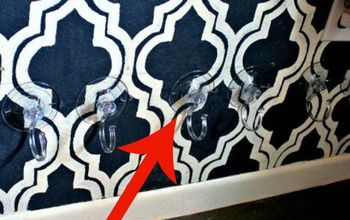Can you add pavers, on top of a plain cement patio?

-
Joan, you can, but its not really advised. Especially in your case. Figures right? The issue you have is that the current patio as I understand is pitching towards your home. This directs water towards the foundation. This issue will not go away by simply covering it over. As water continues to run towards the foundation the patio will continue to sink close to the house and as time goes on it will happen at a faster rate, until you begin to see water issues in the basement. Assuming you have one. If not the foundation of the home will begin to become compromised and cracks will develop. All not good. Instead of pavers you can replace the patio at a much lower cost then you think. Pavers run around anywhere from $.50 to $1.25 apiece depending upon the size, style and color. Add to that sand, and necessary materials to place down on the patio in which the pavers would rest then labor, You are at the cost of demo and replace with a new patio surface all together, plus you will be repairing the issue that can undermine the foundation of your home at the same time. Even if you did place the pavers over the existing slab, water will continue to flow under the pavers and once trapped by the cement slab would flow sideways taking the supporting materials away with it. In short order your pavers would being to sink and shift. Not something you would want after spending all that money on having them put down. While there are those who have done this in the past and for the most part had good luck in doing so, but in your case with water running towards the foundation you will not be quite as lucky as those were. In any case, check with local cement masons, They will surprise you at just how low the cost of replacement can be. If you want a stone look you can have it colored and stamped to look like stone, or have them place slate pavers in various locations that will look pretty nice once its all done.
 Woodbridge Environmental Tiptophouse.com
on Aug 03, 2014
Helpful Reply
Woodbridge Environmental Tiptophouse.com
on Aug 03, 2014
Helpful Reply -
-
So people understand why patios always tend to sink towards the house the answer is really simple. When they build a home they dig out years of compacted soil far enough so the masons can get between the wall and the soil to seal and construct it. Once the house foundation is complete and the framing for the floor is installed. The excavation contractor then can backfill the wall area. However, they cannot pack the soils down anywhere as hard as it once was. Leaving all sorts of air spaces in the soil. Tiny as they are, there is still a lot of space left. Think of this. If you did a hole in the yard and then put the soil back, there is always a pile left on top. If you run a hose on that soil every day for several weeks, eventually the soil comes back to level. What your doing is removing the air pockets that resulted from the back filling. The water arranges the soil so those pockets are filled. The issue is that the contractors do not have any time to spend waiting and watering the soils. And because they cannot pack the soil for fear of pushing in the foundation with the heavy weight of the machines. They simply level the ground out and complete the house. Well over time the soils continue to settle. You can see evidence of this all the time around newer constructed homes. 99% of the time you will see a negative soil level. Which the home owners simply fills up with new soils, plantings and ground cover. In the case of the patio, the slab sits on the top of the soil but cannot be replenished as there is no way to get the soil under the slab. The result is the soil starts to settle along with the slab. As the pitch beings to sink so water runs towards the house, More water results in faster settlement. This results in more unevenness of the slab. The fix can be done in two ways. Remove the slab and replace, or do something called Mud Jacking. Mud Jacking is the process of where the contractor drills small holes about two inches wide or smaller in various places on the patio, Then using a special machine he fills with clean soil and cement he makes a slurry that can be pumped in the holes. This hydraulic action of the liquid cement and soil lifts the patio while it fills the spaces under the cement slab that has caused the settlement. Properly done the slab can be raised several inches brining it back up to level. Overall the process is not that expensive when compared to a new patio. So it may be something to consider if the patio is pretty large in size. Mud jacking is really common on large townhouse complexes where sidewalks are always sinking and shifting. The cost of replacement of these slabs can become quite expensive quickly. Mud jacking makes quick work of the smaller sections of walkway where after only a few short hours people can walk back on them once its lifted. No mess, no digging, no forms to construct. Simple and fast.
 Woodbridge Environmental Tiptophouse.com
on Aug 06, 2014
Helpful Reply
Woodbridge Environmental Tiptophouse.com
on Aug 06, 2014
Helpful Reply -
-
To tide you over until you can replace it, you may want to get an outdoor rug or 2 ($20 at Costco in black or brown 8'x10') or you could stain the existing concrete. When we replaced out concrete (for this same reason) we rented a jack hammer, piled the chunks near the road, had someone come to pick up plus removal of a tree for $500 total. I took us 3 full days and it was painful but not hard, for us it was more painful to pay someone else to do this ($1500). We then had to bring in gravel to buildup the areas (front and back porch and sidewalks), then a compactor, watered down over 2 weeks or so, then more gravel and more compacting then finally new concrete the following spring. We had trouble finding a company to do the finish work due to the size of the project and lots of work in the area. New construction is worth more to a company because of the amount of concrete to be finished, home owner work is less involved. We had no concrete for a year which looking back is probably not so bad because the rain really had a chance to pack the gravel down and the finished product is excellent. The finish work did cost more than the concrete itself. Good luck to you.
 Opal
on Feb 08, 2016
Helpful Reply
Opal
on Feb 08, 2016
Helpful Reply -
Related Discussions
Vinyl plank flooring vs pergo (laminate)
I currently have stinky dirty carpeting in my living room and I want to replace it with a durable flooring that can stand up to dogs and kids.
How to remove popcorn ceiling that has been painted?
Does having a paint over a popcorn ceiling change how I'd remove the popcorn ceiling?
How to apply peel and stick wallpaper?
I want to spruce up my walls with peel-and-stick wallpaper. Has anyone used this before and can advise me as to how to apply it properly?
How to stain wood floor?
I've heard staining is a good technique for updating floors. So how do I stain my wood floor?
Can you lay pavers over painted concrete without removing paint?
Can you lay pavers over a painted concrete surface without removing pa
